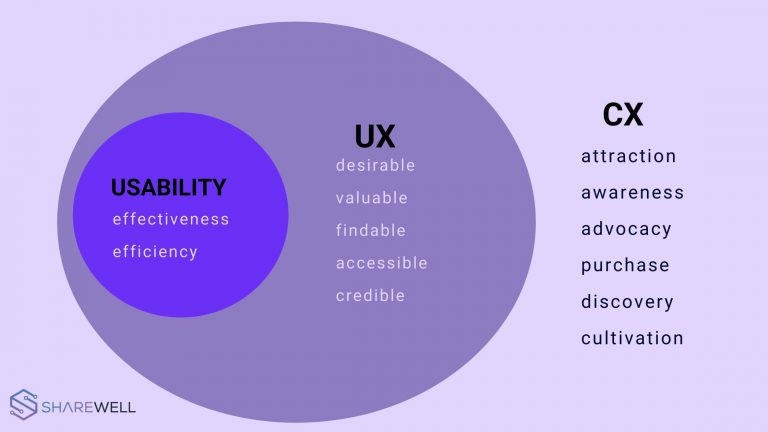User Experience (UX) & Customer Experience (CX). What is the difference?

”User Experience” and “Customer Experience.” They sound pretty similar, right? So, what is the difference? That is what you will discover in this article. In short, User Experience (UX) deals with people interacting with your product and the experience they receive from that interaction. At the same time, customer experience (CX) encompasses all the interactions a person has with your brand.
What is UX (User experience)?
User experience as a term was developed in 1993 by Don Norman. In comparison, he was working with Apple. Don has said, “We have to understand that we don’t inherently understand other people. Even if another person is like us in every obvious way, they are unlike us in one extraordinary way.” That is why the first requirement for an outstanding user experience (according to the Nielson Norman Group) is to meet the customer’s exact needs without hassle.
User Experience (UX) deals with people interacting with your product and the experience they receive from that interaction. UX is measured by the following metrics: success rate, error rate, abandonment rate, time to complete the task, and clicks to completion.
Good digital UX gives a user the ability to:
- Find information on a website fast and easily;
- Complete the desired task smoothly;
- Search Web pages with ease.
What is CX (Customer experience)?
Customer Experience (CX) contains all the interactions a person has with your brand. It can be measured in the overall experience, likelihood to continue using the product, and likeliness to recommend it to others. In essence, UX is part of a broader CX, but CX contains some aspects outside of a product that UX does not.
Good CX gives a user/customer the ability to:
- Have a pleasant, professional, helpful interaction with organization representatives;
- Feel generally optimistic about the overall experience with that organization and everything associated with it.

Example:
Jane searches on Google for a yellow pair of shoes as a gift for her mother and finds shoeshop.com. She then navigates the site to search for yellow shoes. She found the site quickly and effortlessly found a yellow pair of shoes in the correct size. All went smoothly because the information infrastructure, readability, and taxonomy were well-thought-out. Finally, Jane was able to go from entry to shoeshop.com to completing the desired task (finding shoes) in ten clicks over 2 minutes. These are all examples of Janes’s user experience (UX) with shoeshop.com.
But then, Jane had specific questions about how to complete a form, so she called shoeshop.com. After being on hold for over 12 minutes, Jane connected with a shop representative. The rep could not answer Janes’s questions about the form, so Jane had to wait a long time to get a response and a call back from the agent. Jane finally got an answer, completed the form, and submitted it. The next day, she received an email notifying her that form was rejected due to incomplete information. Ultimately, Jane was likely to have to call back with follow-up questions and request additional assistance.
Despite an initial win in UX on shoeshop.com, the shop representative failed in CX because the overall interaction was unpleasant and difficult despite this mock scenario. Jane probably won’t return to shoeshop.com, call them again, or recommend the shop to anyone else.
It can work in reverse, as well. You might have the best advertising, sales team, customer service representatives, and organizational structure (all CX-related items). Still, if customers’ interactions with your website, mobile app, software, or other product create barriers to completing the desired tasks, overall, CX got terrible.
You can see how UX is a part of CX, and each plays a vital role in the overall success of a product, the reputation of your brand, and customers’ loyalty to your brand. Failures in either area lead to a lousy customer experience overall. To begin with, keep the customer in mind as you develop products and services.
Testing user experience vs. customer experience:
UX and CX take different methods to meet the end goal. Here’s how you can test for each.
Testing for UX.
You can uncover and understand how people respond to your product and experience through usability testing. The valuable insight gathered from these tests from what they prefer and disfavored to where they get stuck and confused.
When building a great user experience, you need to focus on making your product enjoyable and user-friendly. Perform usability testing to see if certain goals and tasks can be achieved in an intended way.
You can uncover and understand how real people react to your products and experiences through usability testing. From likes and dislikes to problems and confusion, the valuable insights gained from these tests can be eye-opening to areas of improvement.
One of the quickest and simplest methods of testing is remote usability testing. It’s a remote research method that uses an insight platform (such as Sharewell) to record the screen and voice, depending on the software you choose, of test participants as they engage with your product at home, in the office, or in a specified location.
Testing for CX:
First, the CX test focuses on creating a complete picture of the ups and downs of the customer experience by understanding key indicators and measurements that show how successful people are in achieving their goals. This data can combine complex performance and trading metrics such as conversions and SAT, but usability metrics are also used. Task success and task time can be easily recorded in a small usability study.
Understanding the customer journey is a critical piece of creating empathy. Interviewing customers about their experiences lets you understand their current experiences. With this, you can understand what their ideal journey would look like, then work to adjust what the organization delivers to what you’re hearing from customers.
When trying to make sense between what testing participants do and what their organization needs to know, you should:
- Define business goals—write down what the business wants to achieve, and understand what parts of the customer experience team seek to understand better;
- Identify objectives and execute—focus attention on specific aspects of the customer experience ( ask who, what, when, where, why, how, and how many questions. Create prompts that expose participants to that experience);
- Learn and act—prioritize suggestions, make improvements, and track performance.
CX vs. UX metrics:
There is no one basic metric that you can use to measure the customer experience. While many companies start with the Net Promoter Score (NPS) to understand customer loyalty and likelihood to recommend, they must use complementary metrics that help inform and focus attention on actionable areas of opportunity.
Indeed, customer satisfaction is another popular metric to understand how satisfied customers are with your products and services. Additional CX metrics that you might consider using include:
- Customer Lifetime value;
- Churn rate;
- Meeting expectations.
You want to discover and understand your customers’ perceptions, level of loyalty, and high-level feelings about your brand are the primary focus of CX metrics. Still, exact measurements for gauging this will evolve with the customer’s needs and expectations.
CX metrics are also a superset of UX metrics. Meaning, that the CX team is not only looking at these higher-level metrics, but they’re also looking at UX metrics:
- Conversion;
- Cart abandonment;
- Engagement;
- Perceived credibility;
A great customer experience is built on a foundation of ease of use, emotion, and efficiency, which are the core elements of a solid user experience. You can’t have a great CX without a powerful UX.


